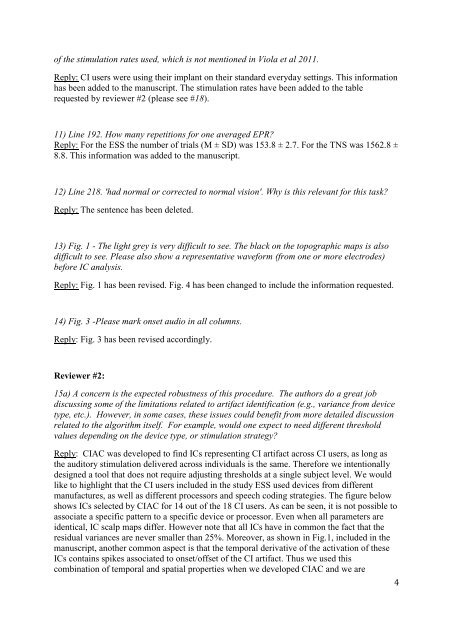Elsevier Editorial System(tm) for Hearing Research Manuscript Draft ...
Elsevier Editorial System(tm) for Hearing Research Manuscript Draft ...
Elsevier Editorial System(tm) for Hearing Research Manuscript Draft ...
Create successful ePaper yourself
Turn your PDF publications into a flip-book with our unique Google optimized e-Paper software.
of the stimulation rates used, which is not mentioned in Viola et al 2011.<br />
Reply: CI users were using their implant on their standard everyday settings. This in<strong>for</strong>mation<br />
has been added to the manuscript. The stimulation rates have been added to the table<br />
requested by reviewer #2 (please see #18).<br />
11) Line 192. How many repetitions <strong>for</strong> one averaged EPR?<br />
Reply: For the ESS the number of trials (M ± SD) was 153.8 ± 2.7. For the TNS was 1562.8 ±<br />
8.8. This in<strong>for</strong>mation was added to the manuscript.<br />
12) Line 218. 'had normal or corrected to normal vision'. Why is this relevant <strong>for</strong> this task?<br />
Reply: The sentence has been deleted.<br />
13) Fig. 1 - The light grey is very difficult to see. The black on the topographic maps is also<br />
difficult to see. Please also show a representative wave<strong>for</strong>m (from one or more electrodes)<br />
be<strong>for</strong>e IC analysis.<br />
Reply: Fig. 1 has been revised. Fig. 4 has been changed to include the in<strong>for</strong>mation requested.<br />
14) Fig. 3 -Please mark onset audio in all columns.<br />
Reply: Fig. 3 has been revised accordingly.<br />
Reviewer #2:<br />
15a) A concern is the expected robustness of this procedure. The authors do a great job<br />
discussing some of the limitations related to artifact identification (e.g., variance from device<br />
type, etc.). However, in some cases, these issues could benefit from more detailed discussion<br />
related to the algorithm itself. For example, would one expect to need different threshold<br />
values depending on the device type, or stimulation strategy?<br />
Reply: CIAC was developed to find ICs representing CI artifact across CI users, as long as<br />
the auditory stimulation delivered across individuals is the same. There<strong>for</strong>e we intentionally<br />
designed a tool that does not require adjusting thresholds at a single subject level. We would<br />
like to highlight that the CI users included in the study ESS used devices from different<br />
manufactures, as well as different processors and speech coding strategies. The figure below<br />
shows ICs selected by CIAC <strong>for</strong> 14 out of the 18 CI users. As can be seen, it is not possible to<br />
associate a specific pattern to a specific device or processor. Even when all parameters are<br />
identical, IC scalp maps differ. However note that all ICs have in common the fact that the<br />
residual variances are never smaller than 25%. Moreover, as shown in Fig.1, included in the<br />
manuscript, another common aspect is that the temporal derivative of the activation of these<br />
ICs contains spikes associated to onset/offset of the CI artifact. Thus we used this<br />
combination of temporal and spatial properties when we developed CIAC and we are<br />
4
















